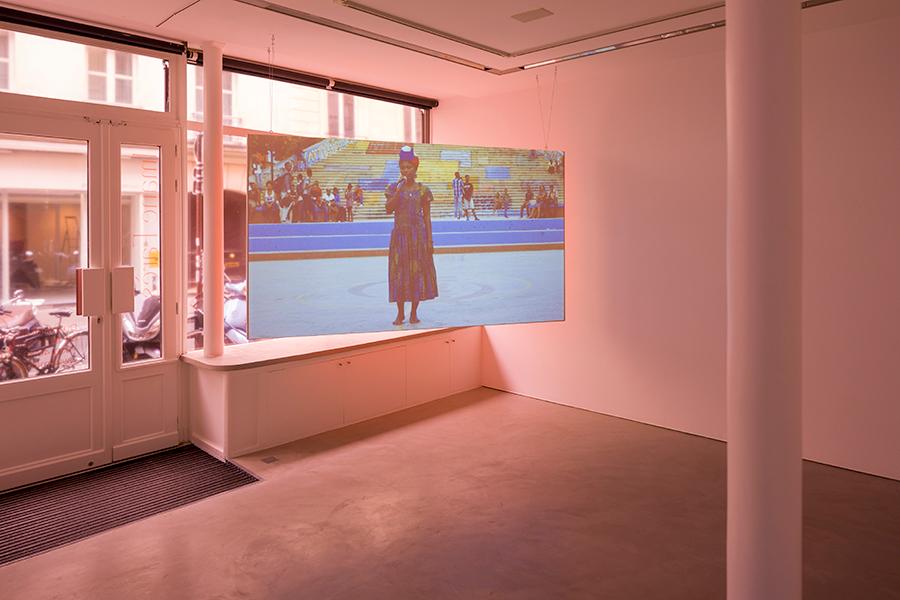Alia Farid’s Films Investigate the Aftermaths of Colonialism
The artist’s exhibition at Galerie Imane Farès, Paris, shows the multiple faces of resistance
The artist’s exhibition at Galerie Imane Farès, Paris, shows the multiple faces of resistance

Consisting of two video installations, Kuwaiti artist Alia Farid’s current exhibition at Galerie Imane Farès draws a parallel between two societies located in Port-au-Prince, Haiti, and on the island of Qeshm in southern Iran. Although separated by more than 12,000 kilometres, the two regions are revealed to have similarities in films that convey how dance, music and ritual serve, in both, as a means of interweaving social connection with overcoming adversity.
Illuminated by a soft, pink light reminiscent of sunrise, the first gallery features Maske Paske Wi (Perform Because Why Not, 2020), a two-channel video installation commissioned by Formerly Known as Witte de With. Mainly shot in the city of Port-au-Prince, in close collaboration with local residents, the work explores coping strategies in the global south. Having suffered from a series of natural disasters and an onerous colonial history, Haiti is one of the poorest nations in the world. Farid’s film, however, does not show images of trauma but of celebration and is centred around the organization of a dance and costume competition. Over the course of 18 minutes, the camera follows the different stages of the contest – from volunteers creating promotional flyers to the day of the festive event itself, with people dressed up in colourful traditional costumes and improvised ones made out of plastic rubbish.

The soundscape of the film combines street noise with conversations in French and Haitian Creole and rhythmic music. At certain points, the sound recedes like a wave, leaving the footage reverberating in silence, only to then return more distinctly, underscoring a particular moment. The joy emanating from this Haitian chronicle, however, contrasts with the conditions in which the country finds itself today. In winter 2019, when Farid was shooting the video, political unrest broke out as president Jovenel Moïse was called to resign due to his handling of Haiti’s economic crisis.
At a time when artists tackling postcolonial discourses have a pronounced presence, Farid’s work succeeds in avoiding the moralizing tone that sometimes emerges from such projects. In Maske Paske Wi, acts of resistance in a society faced with galloping inflation and unemployment are shown through strategies of improvisation, adaptation and appropriation: rubbish becomes costumes, and public space is turned to a stage for performance. Through Farid’s lens, these gestures hint at a parallel reality, in which boredom and resignation are overcome with tenacity and optimism.

In the downstairs gallery, At the Time of the Ebb (2019) documents the annual celebration of Nowruz Sayadeen (Fisherman’s New Year) on the island of Qeshm. A dance at a family gathering is followed by a seaside ritual procession in honour of the summer solstice. Here, men and children dressed in animal and shepherd costumes, accompanied by musicians, parade joyfully through the dunes.
In both films, Farid’s camera remains close to the action: a segment of Maske Paske Wi follows a young man on a motorcycle who flirts back at the camera as it tracks him, while the first part of At the Time of the Ebb features a long close-up of a young man dancing. By homing in on the humanity of these individuals, the artist creates an intimate connection between the spectator and the protagonists that transcends national and ideological boundaries. Wherever such joyful gatherings take place, Farid suggests, they open up a space that exists beyond religious, economic or cultural divisions, proving that resistance can be expressed and lived in many ways. In an interview with Vdrome in May this year, the artist said that she thinks of ‘the past as a way forward’. Perhaps that’s the best way to address postcolonialism: in order to move forward, we need to keep looking back.
Main Image: Alia Farid, At the Time of the Ebb, 2019, video still. Courtesy: the artist and Galerie Imane Farès, Paris
























